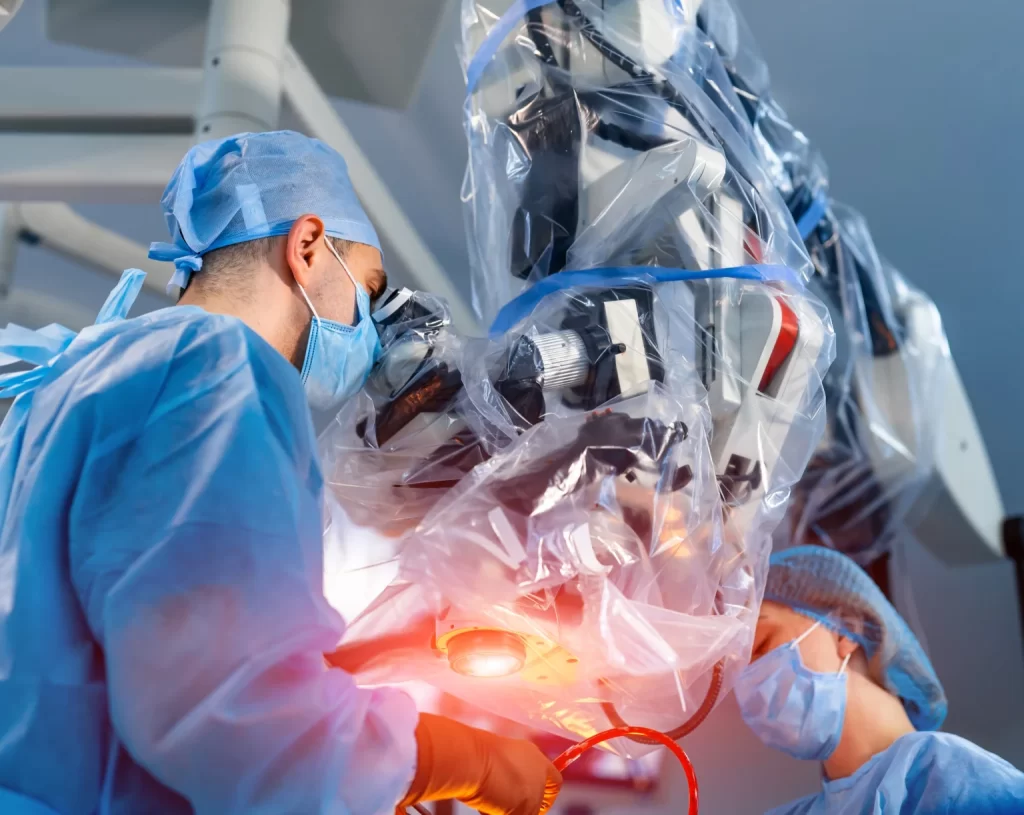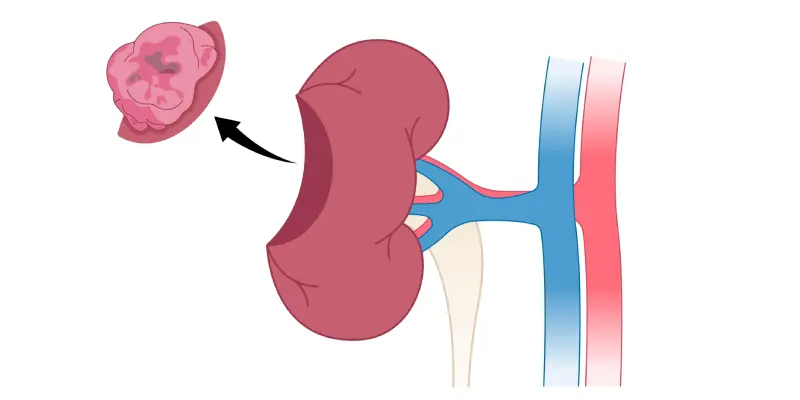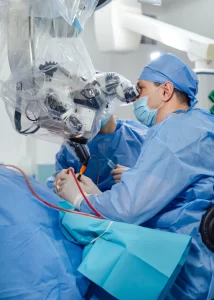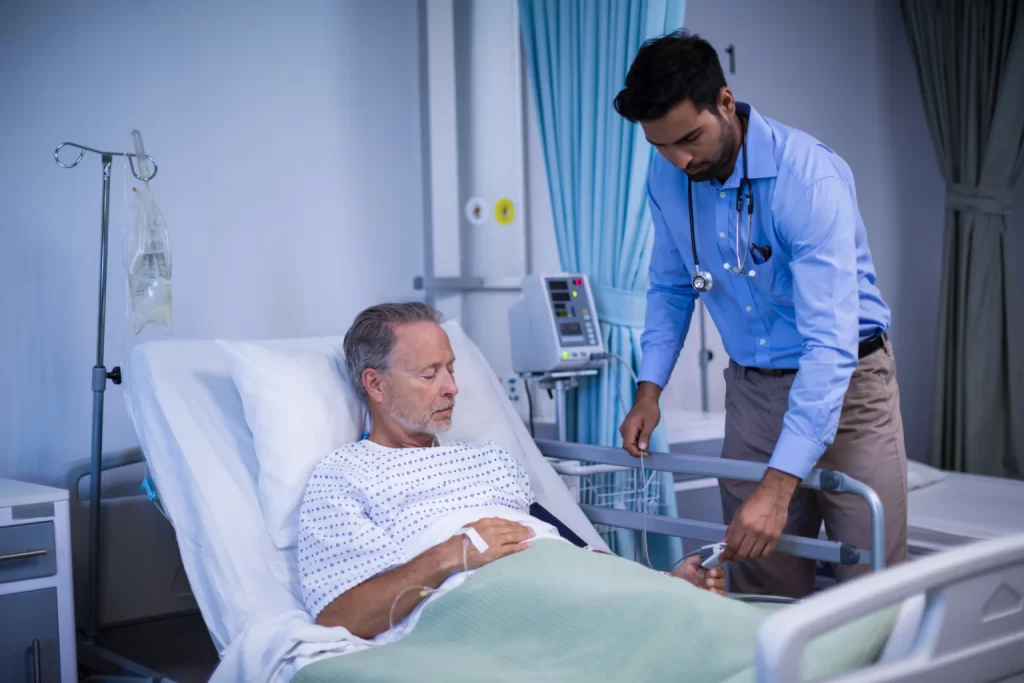Robotic Nephrectomy Surgery in Navi Mumbai
Nephrectomy is a surgical procedure for kidney 000removal. It’s recommended for patients with kidney cancer, benign tumors, or severe kidney injury. It’s done when kidney preservation with partial nephrectomy is not possible
Earlier, the surgery was considered as an open ,invasive medical procedure that would require an extensive hospital stay, a lengthy recovery period, and risks of surgical complications.
With time, advanced surgical techniques, such as laparoscopic kidney removal or robot-assisted surgery, have made the procedure highly effective, less complicated, and precise.
Among the few urologists who are trained to perform robot-assisted nephrectomy is Dr. Soumyan Dey, a highly skilled and experienced robotic surgeon in Vashi, Navi Mumbai. Holding 14+ years of experience and a track record of 7,000+ successful surgeries, he’s become one of the leading uro-surgeons for urological problems.


What is Robot-Assisted Nephrectomy Surgery?
Robotic nephrectomy is a modern, minimally invasive surgery that uses 3D imaging and a robotic arm to remove the diseased part of the kidney (partial nephrectomy or Nephron Sparing Surgery/NSS), or sometimes, the entire kidney is removed (radical nephrectomy), depending on how much the cancer has spread.
Radical Nephrectomy
Robotic radical nephrectomy removes the complete kidney, part of the ureters, fatty tissues, sometimes adrenal glands, and sometimes lymph nodes (if the cancer seems to have spread into the surrounding area). The surgery is recommended for patients with an advanced stage of kidney cancer or multiple tumors in the kidney.




Partial Nephrectomy
For small tumors or cancer in the early stage, a partial nephrectomy can be performed to remove only the damaged portion of the kidney and leave healthy tissues intact. The surgery is typically performed for tumors less than 4 cm, although nowadays we can also conduct robotic partial nephrectomy for larger tumors up to 7cm. The biggest perk of partial nephrectomy is that you still have a functioning kidney.
Robotic nephrectomy doesn’t mean the robot carries out the surgery. The doctor sits at the console and manipulate the robotic arm to make precise cuts. The results are fewer scars, less trauma to the nerves and surrounding tissues, fewer risks, and a faster recovery.
Benefits of Robotic Nephrectomy


Robotic nephrectomy has a few notable advantages over traditional surgery.
• High Precision: Robotic surgery eliminates hand tremors, which is the most common challenge in traditional, open surgical approaches. The robotic arm can conduct the entire operation with great precision. It can rotate and move exceptionally around areas that human hands cannot easily access. This precision is necessary for an advanced kidney preservation procedure, where careful dissection is crucial. • Minimal Blood Loss: Unlike open surgery, robotic nephrectomy minimizes the risk of accidental damage to the blood vessels. Patients undergoing this minimally invasive procedure are less likely to require blood transfusions compared to those who opt for the conventional approach.
• 3D, High-Definition View: The doctor gets a clear, magnified view of the operation site. This allows them to see tiny blood vessels and tissues clearly.
• Small Incision: Robotic nephrectomy involves tiny incisions, which not only offer cosmetic benefits but cause significantly less pain than open surgery. As a result, you may need fewer pain-relief medications. This makes recovery more comfortable.
• Quick Recovery: After robotic nephrectomy, you can return to light activities within a week. You can also resume a desk-based job in 10-14 days. Expect a full recovery in 4-6 weeks. The recovery can vary based on the surgical technique, the complexity of the surgery, your health, and your lifestyle.
• Lower Risk of Post-op Complications: Higher precision means lesser trauma and a minimized risk of complications. Robotic nephrectomy has a lower risk of wound infection, hernia, and other complications compared to its traditional counterpart.
Step-by-Step Guide for Robotic Nephrectomy
Dr. Dey, one of the best urologist in Vashi, Navi Mumbai may run blood tests, triphasic contrast ct scan, DTPA renogram, ECG, and imaging tests for a thorough pre-surgical evaluation. If cancer is detected, further testing may be needed to determine its spread. You are advised to take a liquid diet 24 to 48 hours before the surgery. Water is allowed up to 4 hours before surgery. Here’s what you can expect during robotic nephrectomy:
Step 1: The doctor administers general anesthesia to put you to sleep throughout the surgery.
Step 2: A few incisions (each less than 1 inch) are made on the side of the body. The instruments are inserted through these holes.
Step 3: The robotic arm is guided to make cuts and access the kidney. Your surgeon will control the arm from the console.
Step 4: The doctor will carefully remove the tumor, ensuring that no blood vessels or surrounding tissues are harmed during partial nephrectomy. They take the tumor out by enlarging one of the incisions. If the entire kidney is to be removed, it is usually removed via suprapubic incision ( just like that of caesarian section incision to deliver babies)
Step 5: They will close the incision with staples or sutures.
It can take 3-4 hours or longer for your surgeon to perform a robotic nephrectomy.
What to Expect After Robotic Nephrectomy
You will be taken to the recovery room after surgery. Your vitals are checked for the first few hours. As soon as you feel comfortable, you will be asked to walk to mitigate the risk of complications like blood clots and constipation.
Although robotic nephrectomy results in far less pain than open surgery, it isn’t painless. The doctor will administer pain-relief medication to help manage pain during recovery. A liquid diet is recommended initially. You can transition to a semi-solid diet and then to your regular diet.
You can expect discharge in 2-3 days, depending on the complexity of the surgery and the rate at which your body heals.


Aftercare Tips


• Practice gentle walking at home to prevent clots and regulate bowel movements.
• Do not lift weights heavier than 2-3 kgs for at least 6 weeks or until your doctor gives you a green light.
• Avoid using stairs for 1 to 2 weeks after surgery.
• Avoid driving until you are on pain meds.
• Follow a healthy, kidney-friendly diet with minimal salt consumption, proper hydration, and a balanced diet rich in fibre and other vital nutrients.
• Keep the incision site clean and dry.
• Take antibiotics and pain meds as instructed.
Attend the follow-up visits to have the incision site and stitches reviewed. See your surgeon immediately if you notice heavy bleeding from the incision site, high-grade fever, decreased or no urine output, excessive swelling in the legs, or difficulty breathing.
Frequently Asked Questions
What is the purpose of nephrectomy surgery?
What kinds of nephrectomy are there?
Radical nephrectomy: kidney and surrounding tissue removal in its entirety.
Partially nephrectomy: Only the sick or damaged part of the kidney is removed or thrown away in a partial nephrectomy.
Laparoscopic nephrectomy: A camera and tiny incisions are used in this minimally invasive procedure.
Robot assisted laparoscopic nephrectomy: A camera and tiny incisions are used in this minimally invasive procedure; robotic arms hold the instruments used for dissection allowing a more precise job compared to laparoscopy.
